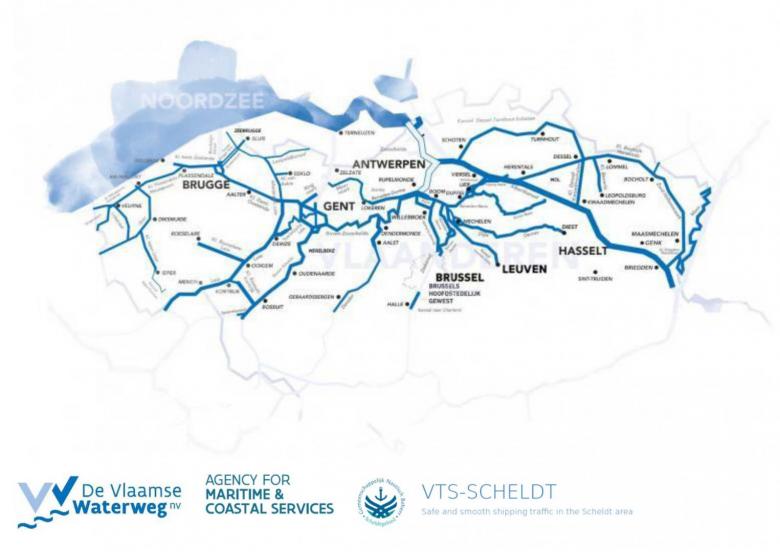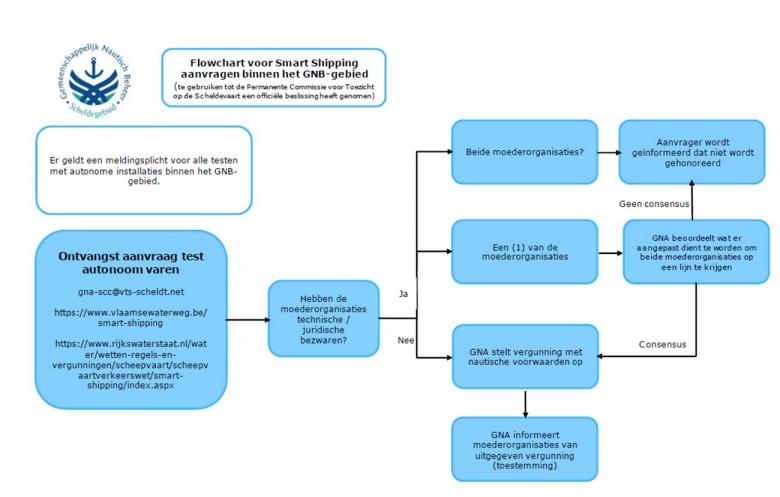Innovatieve projecten
: Smart Shipping E
Smart Shipping E
Smart Shipping
In time, this will cause a reverse modal shift: cargo will be brought back from the waterway to the road. However, the road is already dealing with a lot of congestion while the potential of the waterway is being used less and less. This will lead to major mobility problems. Over the years, an international consensus has grown that the automation of vessels can be a mean to solve a large part of the above problems and to revive transport via the waterways. In this way, the great pressure on our roads will also be reduced. Automated sailing will a.o.:
- Increase the efficiency of transport on inland waterways.
- Cope with the shortage of employees and bring new profiles to the sector.
- Enable new business cases and flow of goods.
- Greening the sector and thus contributing to the realization of the European Green Deal.
To help the future of automated sailing, De Vlaamse Waterweg nv started up the Smart Shipping program. By taking on a pioneering role, De Vlaamse Waterweg nv creates attention for the story of automated sailing. In this way we want to pave the way for companies that are engaged in automated sailing and thus contribute to the future of automated sailing for commercial purposes.
In concrete terms, the Smart Shipping program works around 4 pillars:
- Smart vessels: A smart vessel is used to refer to a vessel that has a minimal form of automation on board. The degree of automation is not important here. Any automated vessel must guarantee the same minimal level of safety as a regular vessel.
- Smart infrastructure: This is waterway infrastructure that is highly automated and operated remotely. Interaction between infrastructure and vessels takes place digitally in order to guide traffic as safely as possible.
- Smart data: This is data sharing that strives to be a smart, smooth and flexible process in which all communication between the government and the users of the waterway is digitized and takes place according to internationally standardized procedures.
- Smart regulation: This is regulation that supports innovation and future-oriented initiatives, and this always with an eye for safety.
Regulatory framework
To ensure that Smart Shipping and the accompanying techniques can be tested and developed in Flanders smoothly and safely, the Vlaamse Waterweg nv has worked on a legal framework that offers more room for innovation. As a first result, a new Decree was introduced in June 2019 . Article 50 and 51 of Chapter 3 describe the possibility of Flemish waterway authorities to give temporary exemptions on certain rules and regulations to enable tests with innovative concepts. Those concepts may also include automated systems on board of a ship or on the shore. The temporary exemptions concern rules and regulations about the crew, the navigation of the ship, the technical aspects or the equipment of the ship, the regulation of shipping traffic and the regulations with regard to the activities on board and ashore. The deviations cannot relate to provisions on supervision and enforcement and to provisions of a criminal nature.
The exemptions have a maximum validity period of one year and can be renewed depending on the needs, without the total validity period of a deviation being allowed to exceed five years. When admitting for the experiments or pilot projects, the following matters must in any case be determined:
- what the purpose of the experiments or pilot projects is;
- on which waterways, waterway sections or parts of the port area the experiments or pilot projects are carried out;
- for which period the admission applies;
- which rules can be deviated from and, where relevant, under which conditions deviations are permitted;
- which safety measures are taken for the implementation of the experiments or the pilot projects.
The waterway manager or the port authority may withdraw the admission in whole or in part if, in his opinion, the safety as a result or partly as a result of the experiments or the pilot projects is endangered.
The next step is to create a legislative framework that allows automated navigation for commercial use. This is not only a Flemish, but also an international matter: the Flemish regulations are based on international regulations. The Vlaamse Waterweg nv wants to share its knowledge with international organizations in order to support them in researching the impact of Smart Shipping on international legislation and regulations and has therefore started a scoping exercise in the CCNR and the UNECE.
Test area
The introduction of the Collective Decree enabled De Vlaamse Waterweg nv to open up its waterway network as a testing area for automated vessels. Tests can only be carried out with the permission of De Vlaamse Waterweg nv.

How does it work?
If an organization wants to carry out a test on the waterways of De Vlaamse Waterweg nv, The Agency for Maritime and Coastal services or in the Flemish part of the VTS – Scheldt area (see below), the single point of contact (SPOC) must be contacted. Contact details can be found further on this page. The SPOC will send you the application forms.
The evaluation committee of De Vlaamse Waterweg nv will assess the application. If the application is approved, the applicant will be contacted for an interview in which all practical matters will be discussed. After that, everything can be recorded in an agreement. The tests are then performed according to the code of conduct and the agreement.
During testing, the testing organization completes a report on their test. This report states:
- A description of the testing activities, including date, position and time
- A description of the problems encountered by the tester and how they were solved
The report is signed and sent to the SPOC for validation after the end of the test.
VTS – Scheldt area
For the VTS - Scheldt area, submitting an application as above is the standard when the test takes place in Flanders. If the test takes place in the Netherlands, the link to Rijkswaterstaat must be used. A specific procedure then follows.

Contact
For questions and comments, the Single Point of Contact is happy to help you:
Gert Morlion
RIS Projectmanager – Smart Shipping
smartshipping@vlaamsewaterweg.be